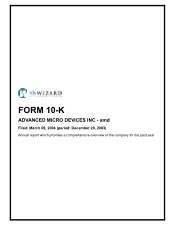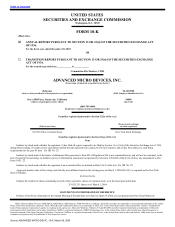AMD 2003 Annual Report Download - page 9
Download and view the complete annual report
Please find page 9 of the 2003 AMD annual report below. You can navigate through the pages in the report by either clicking on the pages listed below, or by using the keyword search tool below to find specific information within the annual report.
Table of Contents
The microprocessor market is characterized by short product life cycles and migration to ever-higher-performance microprocessors. To compete
successfully in this market, we must transition to new process technologies at a fast pace and offer higher-performance microprocessors in significantly greater
volumes. We also must achieve manufacturing yield and volume goals while producing these microprocessors in order to sell them at competitive prices. For
more information about competition in the microprocessor market, see the section entitled “Competition,” below.
We believe that worldwide demand for PC microprocessors will increase in 2004 compared with 2003. Factors that we believe will stimulate growth in the
demand for PC microprocessors include an anticipated replacement cycle for older PC systems, lower-priced PC systems, enhanced product features, strategic
purchases of new PC systems to deploy new tools and technologies, and improved economic conditions.
Microprocessor Products
We currently offer microprocessor products for desktop and mobile PCs, servers and workstations. Our microprocessors are based on the x86 architecture.
In addition, we design them based on a superscalar reduced instruction set computer, or RISC, architecture. RISC architecture allows microprocessors to perform
fewer types of computer instructions thereby allowing the microprocessor to operate at a higher speed. We also design our microprocessors to be compatible with
operating system software such as Windows XP, Windows 2000, Windows NT ®, Windows 98 (and Windows predecessor operating systems), Linux, NetWare ®
and UNIX.
Our microprocessors for desktop PCs consist of four product brands: AMD Athlon 64 FX, AMD Athlon 64, AMD Athlon XP, and AMD Duron ™
processors. We introduced the first Windows-compatible, x86 architecture-based 64-bit PC processor, the AMD Athlon 64 microprocessor, in September 2003,
an introduction date that we changed from our originally stated date due to a combination of factors, including the features and functionality of these new
processors in comparison to our existing PC processors, AMD Athlon XP, the fact that demand for our AMD Athlon XP processors was greater than expected,
and the state of the microprocessor market at the time the introduction was planned. AMD Athlon 64 processors are based on the AMD64 technology platform,
which extends the industry-standard x86 instruction set architecture to 64-bit computing. We designed our AMD Athlon 64 processors to run both 32-bit and
64-bit applications simultaneously, enabling users to protect their information technology investments by continuing to use their 32-bit software applications
while implementing 64-bit applications on the timetable of their choice. We design our AMD Athlon 64 processors for sophisticated PC users and businesses that
seek to access large amounts of data and physical memory. Simultaneously with our introduction of the AMD Athlon 64 processor, we introduced the AMD
Athlon 64 FX processor, designed specifically for gamers, PC enthusiasts and digital content creators who require products that can perform graphic-intensive
tasks. We design our AMD Athlon XP processors for the value market and offer PC users and small to medium businesses affordable processors that can meet
their core computing needs. We also design AMD Duron processors, which we sell primarily in cost-sensitive emerging markets. Most of our microprocessor
product sales in 2003 were of our AMD Athlon XP microprocessors.
Our microprocessors for the mobile computing market consist of mobile AMD Athlon 64 processors and AMD Athlon XP-M processors. Our original
equipment manufacturer, or OEM, customers incorporate these processors into a variety of notebook designs, including full-size and thin-and-light notebooks.
We have designed mobile processor products for high-performance computing and wireless connectivity. They feature advanced power management from AMD
PowerNow!™ technology which offers reduced power consumption and extended system battery life. During 2003, we primarily provided mobile computing
products for the full-size or desktop-replacement segment of the mobile computing market. Our strategy for 2004 is to expand our product portfolio to address
the thin-and-light segment of the mobile computing market and increase our share in the full-size segment of this market.
4
Source: ADVANCED MICRO DEVIC, 10-K, March 09, 2004






















